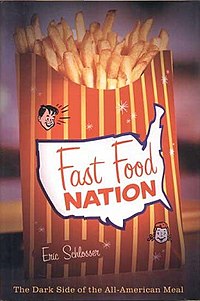Wednesday, May 8, 2013
Experiential Journal: Exploring the Underside of Fast Food
By Ashley Intveld
It’s fast, easy, cheap, and somewhat tasty. Fast food has become a go-to option for on-the-go Americans because of its convenience and ability to fuel the fast-paced lifestyle. In his book Fast Food Nation, Eric Schlosser exposes the truth behind these minute-meals and how they’re not only destroying our health, but our safety, economy, and environment as well. Through gross examples (by gross I mean that literally) and unvealed sales tactics, Schlosser exposes the ugly truth behind America’s serve-with-a-smile industry.
Fast food industries feed on the naïveté of children through their marketing techniques. With cartoonish mascots and toys in every meal, children are suckered in at the expense of their health. Parents fall for the trap because it satisfies the child at a cheap price. This kind of marketing also ensures what Schlosser coins “brand loyalty,” which means young customers will develop nostalgic emotions toward the company’s mascots and therefore be a consumer for life. Not to mention the fact that fast food marketers prey on young minds through their educational institutions as well. Reductions in corporate taxation invite these corporations to sponsor schools, and the information students received is then bias in the favor of the sponsor’s corporation.
Schlosser also touches on the dangers of the meat packing industry and its working conditions for laborers, who are often immigrant workers. According to Schlosser, meat packing workers have the highest numbers of injuries of any career in the United States. Although the hazardous working conditions for the human employees should be reason enough to close down the industry, the sanitation is atrocious. Often meat processing leads to rendering dead animals and chicken manure into cattle feed. The cattle then consume this hazardous concoction which taints the meat that we eat. That’s how our world was introduced to the horrors of Mad Cow Disease and E. coli poisoning.
In reading this book throughout the semester, I can honestly say it makes me think twice about all the food that I buy when I’m on the run. Though fast food has never been overly appealing to me, I’ve found that these corporations have gotten cleverer with hiding their dark, disgusting secrets, as the general public has become more aware of their tactics. It’s obvious that consumption of fast food on a regular basis can lead to obesity which leads to a plethora of other diseases. But at what cost? Convenience? Wouldn’t it be easier to pick an apple off an orchard tree? Or meet a local farmer and actually shake hands with the person preparing your food?
There’s a blindfold on American consumers and we keep it firmly in place for the sake of convenience and taste. I would highly recommend this book to anyone interested in investigative reporting and the fascinatingly repulsive food industry in America.
Subscribe to:
Post Comments (Atom)

No comments:
Post a Comment